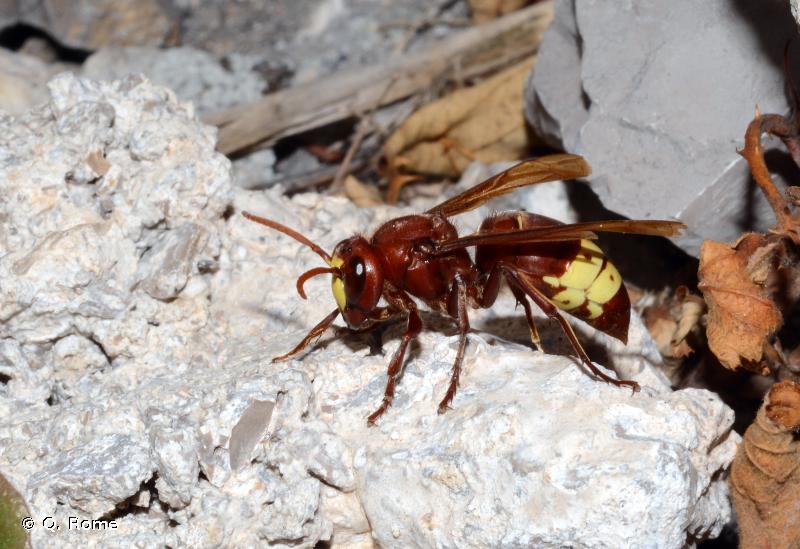
cd_nom

| Author : Q. Rome |
 |
To get the picture, please visit:
Quentin Rome
Despite the Creative Commons license, please inform the author of the use which will be made of his photo

| Author : Q. Rome |
 |
To get the picture, please visit:
Quentin Rome
Despite the Creative Commons license, please inform the author of the use which will be made of his photo

| Author : Q. Rome |
 |
To get the picture, please visit:
Quentin Rome
Despite the Creative Commons license, please inform the author of the use which will be made of his photo
Taille/poids :
Longueur du corps : 20 à 25 mm pour les ouvrières et les mâles, 27 à 35 mm pour les reines.
Diagnose :
Présence d'un rétrécissement (pétiole) entre le thorax et le gastre. Les ailes au repos sont pliées longitudinalement. Entièrement roux à l'exception de la face antérieure de la tête et des 3e et 4e segments de l'abdomen qui sont jaune. Les nids sont en général installés dans des cavités, dans le sol ou des bâtiments, sans enveloppe. Lorsque le nid est aérien, il peut être accroché à un bâtiment ou de la végétation, et possède alors une enveloppe grise (bois) mêlée de particules du sol.
Détermination :
Simple
Espèces proches :
Vespa velutina est à dominance noire. Vespa crabro présente un thorax noir avec des tâches rouges plus ou moins étendues, l'abdomen est noir rayé de jaune.
Période d'observation :
Adultes observables d'avril à novembre, nids (dont abandonnés) visibles toute l'année.
Biologie-ethologie :
Le cycle de vie est annuel. La jeune reine hiverne à l'abri des intempéries. Elle se réveille au printemps, recherche des liquides sucrés pour se nourrir, puis un emplacement où fonder son nid (arbre creux, intérieur d'un bâtiment, etc.). Elle élèvera ses premières larves en les nourrissant avec des proies (abeilles, guêpes et mouches surtout). Les colonies sont de taille similaire à celles de Vespa crabro, soit environ 1000 individus à son apogée. Les individus sexués quittent le nid à l'automne, le reste de la colonie mourra pendant l'hiver. L'espèce n'est pas agressive si son nid n'est pas dérangé, mais elle risque de poser des problèmes aux activités apicoles.
Biogéographie et écologie :
ROME Quentin(UMS 2006 Patrimoine Naturel (OFB / CNRS / MNHN)),2021
Continental
Metropolitan France
Overseas
Marine
Metropolitan France
Overseas
The map presents a summary at the 10 x 10 km grid of the observation data for the species transmitted to the SINP. These data have been subjected to validation filters.
The map presents a reference distribution layer of the species at the scale of departments and marine sectors. The presence and absence data were established by expertise within a network of partners. This reference distribution is used in the validation process of the SINP data at the INPN level.
Corresponds to a report on the basis of at least one observation proved within a period of 10 years (20 years for little-known invertebrates) preceding the year and no presumption of extinction since obtaining the last data nor doubt on reproductive and implemented nature of this population. For migratory species, the presence indicated concerns areas of reproduction.
This status is based on one or more of the following criteria:
This point covers the absence, more difficult by nature to demonstrate than presence. This status is based on one or more of the following criteria:
This status must be assigned to a department in which the presence of the species is casual.
Particular case of absence due to a proven extinction less than a half century ago (older disappearances are treated as "no probable or definite").
In the state of knowledge, we can not comment on the presence or absence in the current department. This is the default status when not comprised in one of the previous categories or whenever there is doubt.
The map shows the global distribution of the species based on GBIF data (Global Biodiversity Information Facility).
